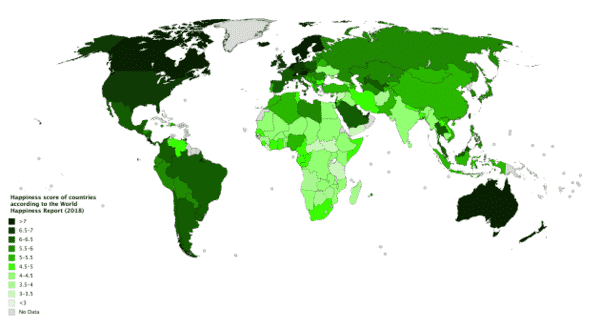How do you measure happiness perhaps health
How do you measure happiness perhaps health
Measuring Health And Happiness
The small country of Bhutan in the Himalayan mountains is over one thousand years old. In the past it was a poor country and not many people visited it. But nowadays, it is becoming more and more popular with tourists. Medicine and health is improving and its economy is growing. King Jigme Singye Wangchuck, the king of Bhutan until 2006, talked about his country’s ‘Gross National Happiness’. In other words, he thought happiness is the way to measure the country’s development. But how do you measure happiness? Perhaps health is the best way because a famous doctor once said, ‘Happy people generally don’t get sick.’ It’s also easy to measure how many people feel ill or unhealthy in a country. For example, one survey says Iceland is the ‘healthiest country in the world’ because men and women live a long time there, the air is very clean and there are more doctors available per person than anywhere else in the world. However, there was another survey of the happiest countries in the world and Iceland was not near the top. The questions on this survey included: How much do you earn? How healthy are you? How safe do you feel? After visiting 155 different countries, the researchers decided that Denmark feels happier than other countries. So does happiness equal money and good health? Not according to the artist Erik Krikortz. He feels that there are other ways of measuring happiness. Krikortz has a website and visitors click on different happy or sad faces to comment on how well they sleep, their family and friends, their level of stress, their inspiration and their physical activity. When you finish, his website adds the results for each area and it gives you a final result for your happiness. In his home city of Stockholm, Krikortz also shows the results of his survey as different coloured lights on the side of a large building in the city. For example, red means the people of Stockholm are very happy, green is OK and purple means many people are sad. ‘A lot of people look at the building every day and see how “we” are,’ Krikortz says. The coloured lights are also useful if you feel like visiting the city. For example, if the lights are red, you know the locals are feeling happy!
Modal verbs: should, must, have to
The Secrets of a long life
The island of Okinawa in Japan has some of the oldest people in the world. It’s famous for its high number of centenarians – men and women who live beyond 100 years of age. There have been many scientific studies of their lifestyle and you can even buy cookery books based on their diets. Some of the reasons for their good health are that they …
Read the article and choose which sentences (1–3) is the best summary of the main argument?
Measuring Health & Happiness
The small country of Bhutan in the Himalayan mountains is over one thousand years old. In the past, it was a poor country and not many people visited it. But nowadays, it is becoming more and more popular with tourists. Medicine and health are improving and its economy is growing. King Jigme Singye Wangchuck, the king of Bhutan until 2006, talked about his country’s ‘Gross National Happiness’. In other words, he thought happiness is the way to measure the country’s development.
But how do you measure happiness? Perhaps health is the best way because a famous doctor once said, ‘Happy people generally don’t get sick.’ It’s also easy to measure how many people feel ill or unhealthy in a country. For example, one survey says Iceland is the ‘healthiest country in the world’ because men and women live a long time there, the air is very clean and there are more doctors available per person than anywhere else in the world.
However, there was another survey of the happiest countries in the world and Iceland was not near the top. The questions on this survey included: How much do you earn? How healthy are you? How safe do you feel? After visiting 155 different countries, the researchers decided that Denmark feels happier than other countries.
So does happiness equal money and good health? N ot according to the artist Erik Krikortz. He feels that there are other ways of measuring happiness. Krikortz has a website and visitors click on different happy or sad faces to comment on how well they sleep, their family and friends, their level of stress, their inspiration and their physical activity. When you finish, his website adds the results for each area and it gives you a final result for your happiness.
In his home city of Stockholm, Krikortz also shows the results of his survey as different coloured lights on the side of a large building in the city. For example, red means the people of Stockholm are very happy, green is OK and purple means many people are sad. ‘A lot of people look at the building every day and see how “we” are,’ Krikortz says. The coloured lights are also useful if you feel like visiting the city. For example, if the lights are red, you know the locals are feeling happy!
Measuring happiness and well-being: how can we do it?
How can you measure happiness when it means different things to different people? As Ed Gould explains, it is possible. Here are the techniques used in mapping and measuring happiness and well-being, and the reasons why it’s important.
Measuring happiness is becoming an important tool. Economic growth, physical health and confidence in the future prospects of a person or country are all important factors when assessing and comparing them. However, no institution, nation or group of people can really be properly understood without also factoring in a number of other elements.
And one of those key elements that is becoming increasingly looked upon by academics is happiness. Nevertheless, measuring happiness presents certain challenges. Indeed, how and why should we bother with it at all?
Measuring happiness is tricky because it relies on mapping subjective well-being. Of course, subjective well-being is just that: an idea that will vary from person to person.
In other words, measuring happiness in one individual could mean that their subjective well-being is recorded at a much higher level than another. Who could tell if this is truly accurate? Who’s to say that the answer given is in any sense ‘wrong’? Shouldn’t we abandon the idea of measuring happiness as too complex or too nuanced?

Different strokes: happiness means different things to us all
Well, no. This is because refraining from measuring happiness with the best tools available will result in a gap in scientific knowledge. Without some form of assessment of happiness and well-being, it would be impossible to compare the outcomes of certain long-term policy decisions, for example.
One could not compare the differences between two countries undergoing different economic circumstances fully, either. From a political, sociological and from a sheer interest in humanity point-of-view, measuring happiness has never been so important. Let’s examine how to measure happiness and delve into the methodologies on offer in a little greater depth.
Happiness: how to measure it
According to Mark K Setton, D.Phil, the CEO and founder of The Pursuit of Happiness, leading positive psychologists are focussing on the cultivation of positive emotions with a variety of techniques nowadays. The trouble is that well-being and happiness cannot be measured in a single snapshot to determine which of those techniques are most effective.
“Refraining from measuring happiness with the best tools available will result in a gap in scientific knowledge.”
Setton argues that happiness is rather like physical well-being: multiple measurements and assessments must be made to understand the body’s well-being in the round. Likewise, just asking someone how happy they feel would be overly simplistic. As such, his organisation backs the questionnaire approach whereby multiple questions are put to participants in study programmes.
As data from these subjective well-being surveys is collated, so spikes and anomalies are evened out. Ideally, discrete data is collected which can then be quantified. Therefore, questionnaires should not ask open questions, such as “How happy are you?” Instead, they should ask participants to score themselves with an instruction to score their happiness level on a scale, for example, between one and ten.
How to measure happiness: questionnaires
There are now many questionnaires that are widely used by academics and scientific researchers to assess happiness levels across the globe. Here are four of the most important:
According to Todd B Kashdan of the Department of Psychology at the University of Buffalo, the 29-question Oxford Happiness Inventory, which was developed for use back in 2002, overlays some of the important factors involved in assessing oneself in terms of happiness.

How to measure happiness? Start with a questionnaire
Kashdan argues that measures like self-esteem and sense of purpose are taken in the survey but that they’re not properly differentiated from one another, leading to an overly ambitious correlation between them.
In spite of the criticism of the particular ways in which questionnaires are put together, few psychologists today would argue that they constitute the best way we currently have of quantifying the qualitative assessments needed to measure subjective well-being.
While the academic debate rages on about the best way of measuring happiness in various questionnaire forms, the scientific community continues to make these assessments in order to better understand happiness and how it impacts on both the individual and society as a whole.
Measuring happiness: unifying the methodologies
Of course, if one academic study into subjective well-being uses a particular questionnaire, then the results found in that sample group can only inform us of that group of people and of other groups which have been subject to assessments using the same methodology.
If academics use their own questionnaires, then no matter how carefully the data they collate has been analysed, it’s not possible to pool such datasets. Therefore, relatively simple questionnaire formats have been developed so that researchers can use the same scales and the same form of wording around their questions in order to obtain results which can be used together.
The Subjective Happiness Scale is a good example of this sort of approach. The questionnaire can be downloaded by anyone so long as it’s for academic research and not commercial use. It uses a simple scoring system of one to seven which cleverly allows people to place themselves in the middle of the scale, at number four, if they feel that’s appropriate for them – not all scales allow for this.
Additionally, it allows researchers to ask negative questions, like those about being unhappy. All the researcher needs to do is to reverse the scoring system to continue to obtain viable and simple-to-understand results. Another questionnaire that does this is the Better Life Index, the sophisticated survey from the Organisation for Economic Co-operation and Development (OECD). For a more detailed look at the questions it uses to measure happiness, do explore the OECD Guidelines on Measuring Subjective Well-being.
“Happiness is rather like physical well-being: multiple measurements and assessments must be made to understand the body’s well-being in the round.”
With small sample groups, this approach works very conveniently. For mass observations surveys, such as those which measure and compare happiness in every country of the world, it’s essential. The Organisation for Economic Co-operation and Development (OECD) has now developed academic guidelines so that data of a similar nature can be gathered.
Since 2011, when the OECD published its ‘How’s Life’ report, it has been involved with standardising the ways in which the statistical data in many areas are collected, including those devoted to measuring happiness. As such the OECD has made great strides in helping us to understand human happiness around the world. ●
Written by Ed Gould

Measuring Happiness? The Top Happiness Scales and Questionnaires

The Top Happiness Scales / Questionnaires
The following is a list of the most widely used and respected questionnaires measuring happiness. As you can see, we can discover some major differences in how they approach the issue, which reflect different definitions and perceptions of happiness.
Satisfaction with Life Scale (Deiner, Emmons, Larsen and Griffin)
Panas Scale (Watson, Clark, Tellegen)
And this is Todd Kashdan’s thoughtful critique of the above scales:
We should mention a recent measurement of Subjective Well Being created by the OECD, as part of their very sophisticated and broad ranging survey, the Better Life Initiative. This initiative is fascinating and includes some eye-popping graphics. To see their detailed report on SWB and the questions they used to measure it, please refer to the OECD Guidelines on Measuring Subjective Well-being.
The strong point of both the Panas Scale and the OECD Subjective Well Being scale is that they measure both positive and negative affect, which, as one might expect, have a clear inverse correlation.
Measuring Happiness and the Science of Happiness
At the Pursuit of Happiness project, we try to collect and analyze the most scientific studies on happiness and subjective well-being (SWB). The question is, how does one evaluate what the most “scientific” studies are? Naturally, randomized and controlled studies are more reliable. These kinds of studies often require an enormous amount of effort and funding, and many studies that claim to do this are flawed in various ways.
One major challenge to reliability is how these studies measure the happiness or SWB of their subjects. For example, asking people “how happy are you?” might invite a very different answer than the question “how satisfied are you with your life?” Personally speaking, if someone asks me how happy I am, I tend to think about my feelings. If someone asks me how satisfied I am, I tend to think about my external, socioeconomic situation as well as my state of mind.
The Happiest Countries in the World
This is perhaps one reason why the Gallup Global Emotions survey, which focuses mainly on emotional well-being, and the World Happiness Report, which curiously enough focuses on satisfaction with socioeconomic conditions, rank the happiness of countries quite differently.

Tracking “Happiness Skills”
Finally, the Skills-based Happiness Quiz (SHQ) offers a new twist. It doesn’t exactly measure how happy you are presently, but instead explores what you are actually doing that is strongly related to various correlates of Psychological Wellbeing, or what we unscientifically call the 7 Habits of Happy People. For the sake of full disclosure, it was designed by the team working on this website. It is more of an educational instrument than a psychometric one, offering respondents insight into how they can improve their life skills to stimulate happiness & mental health resilience.
How to Measure Happiness
Denmark is the happiest nation in the world, according to the World Map of Happiness and World Values Survey. So, what Denmark has done, every country should do. There are five factors that can be used to measure happiness.
The Biological One
Biologically you can measure your happiness. Our hormones level in the body, the other factors clearly indicate whether we are happy or not. The indicators are:
Behavioral One
How a person is behaving in social life reflects how happy he or she is and this the way to measure happiness.
Other Reports
Another effective way to measure the happiness of a person is taking the report from others. In this pattern, you can give a questionnaire to people around you and ask to give you a ranking about your happiness level based on your response.
Take the Self Report
Among all the methods used to measure happiness, this is one of the most effective ways. Take the self-report and analyze your actions in different situations. The internet is full of questionnaires that carry questions whose result helps you to analyze how happy you are.
Check your Emotional Status
This factor has no logic, but this helps in measuring our happiness to a big extent. We all know what makes us happy and whether we are happy or not. No one can judge how happy we are, so the best way to measure happiness is through self-analysis.
Write Your Daily Dairy
Develop the habit of writing your daily diary. Write everything that you analyzed from your whole day activity in your diary. After a week or a month read that diary and analyze. The content in your diary will tell you whether you are a happy person or not. This will help you in measuring your happiness. What you have to check in your diary is:
TIPS
This is not an expert method. To measure your happiness correctly takes the help of a counselor.
